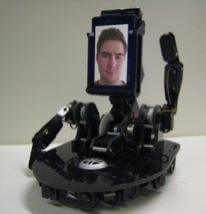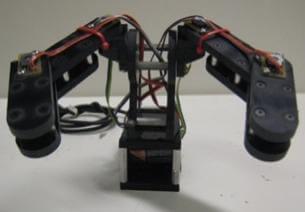
It may not make sense to your binary minds, robots, but humans talk with their hands. Thankfully, engineers at the Personal Robotics Group at MIT Media Lab have developed MeBot, the first telepresence robot with a head and arms that move. Operators sit in front of a camera and a special sensor tracks their head orientation. A screen on the robot shows the person’s face and moves on a “neck” to mimic his or her pose. MeBot’s arms are moved using a controller that resembles the bot’s actual limbs. It’s a pretty cool setup, and it makes a difference. Psych experiments performed by the developers showed that humans responded better to a telerobot with a dynamically moving body. That makes sense, and MeBot’s simple innovation of adding body language could help make telepresence an accepted way to cooperate with colleagues over long distances. Check out the robot in action in the clip from MIT below. That little bot is adorable! How could you not want to work with it?
Video conferencing telepresence is a developing trend, replacing millions of dollars spent in business travel. Telerobots offer a distinct advantage over webcams, allowing you to leave the conference room and interact with others in an impromptu way. We’ve seen some great TP robots from Anybots, and Willow Garage, but MeBot is the first with moving limbs and the difference is notable. I anticipate that arm and head movements used by MeBot operators could be recorded and used to help generate body language scripts for non-telepresence robots. Eventually, body language will help us work with robots in traditional human roles, like school teachers. From there it’s just a short jump to humanoid robots being accepted into society at large.
MeBot is the thesis project of Sigurdur Orn Adalgeirsson, and he used the bot to analyze the benefits of body language in human-robot interactions. Adalgeirsson performed a psychology experiment wherein a volunteer would be asked to select objects they would want on a unplanned trip to the desert – a standard survival scenario. An operator, using MeBot, would interact with the volunteers to influence their selections from various pairs of tools in front of them. For some people, MeBot was active (using body language) and in some cases it was passive (articulation was turned off). The study found that when MeBot was active the test subjects reported feeling more engaged, more cooperative, and happier about the test.

While the psych test was relatively small (just 48 subjects), it showed a nearly universal preference for articulated telerobots. These volunteers weren’t all ultra savvy telepresence professionals either, one-third had never used TP technology before. Certainly Adalgeirsson’s study could have been larger and more rigorous, but I think it suggests what common sense already tells us: humans prefer working with things that look and move like humans.
Does that mean we’re robot-prejudiced? Definitely. But more importantly it demonstrates why it is critical for humanoid robots to act more human if they want to be accepted. Acceptance is going to be key if telepresence is going to continue growing as a business practice. Teamwork and cooperative planning is hinged upon coworkers acknowledging each other as equals. That’s hard if one of you is a talking head on a screen with wheels. Once we start working with each other through telerobots, it will free us to work anywhere from anywhere. It will also allow us to start cooperating meaningfully with robots who have no operators besides their own AI. Whether or not there’s going to be someone holding the puppet’s strings, dynamic body language is definitely a great innovation for the telepresence field. Good job, MeBot, high fives!
[image and video credits: MIT Media Lab]
[source: Personal Robotics Group at MIT Media Lab, Sigurdur Orn Adalgeirsson Thesis and Website]


